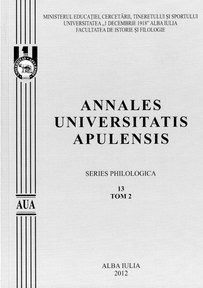La voie vers l’entente
The Way to Inter-Comprehension
Author(s): Maria StoicoviciSubject(s): Cultural Essay, Political Essay, Societal Essay
Published by: Universitatea »1 Decembrie 1918« Alba Iulia
Keywords: diversity; culture; intercultural communication; adaptation; education
Summary/Abstract: At the peak of the globalization age, countries become increasingly aware of the inescapable diverse character of their societies, which emerged from the political, military, social, economic or technological upheavals and which includes the multilingual aspect. Globalization facilitates the permanent contact between people belonging to different cultures, a process which supposes in the first place intercultural communication, which is more efficient when it relies on common cultural features and shared values. This is a complex mechanism which implicates the interpersonal relationships, the emotions, the representation of the world and which mobilizes the conscious and the unconscious sides of the individual. Intercultural communication requires that one should be both transmitter and receiver and, in this way, one should master the codes of one’s own culture and those of the culture of his interlocutor, with the aim of finding the adequate frequency for communication. When the cultural habits are very different, they interfere with communication and first create stereotypes and then dissonances which get amplified when each party resorts to its own cultural heritage in order to react and where neither the one nor the other identifies the cultural origin of the dissonance. In order to ensure a peaceful coexistence, countries must be preoccupied by the cultural adaptation of their inhabitants. The latter process is a difficult one and supposes, on the one hand, reciprocal cultural influences which cause the individuals and the groups to finally share a common culture and, on the other hand, implies major changes in their status. This can be achieved, among other means, by a sustained process of intercultural education, conducted by educators capable of a sound management of cultural diversity in their classes. It is not enough to apply measures in the educational system which are intended to sustain the right to linguistic and cultural diversity. It is equally necessary to sustain the development of the pluricultural competences of both educators and learners, with the aim of achieving the great aim of "a life in common", which means reciprocal understanding.
Journal: Annales Universitatis Apulensis. Series Philologica
- Issue Year: 13/2012
- Issue No: 2
- Page Range: 329-342
- Page Count: 14
- Language: French

